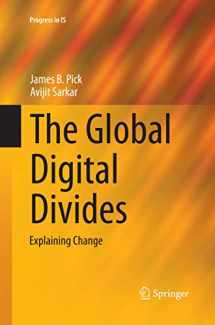
The Global Digital Divides: Explaining Change (Progress in IS)
ISBN-13:
9783662511015
ISBN-10:
3662511010
Edition:
Softcover reprint of the original 1st ed. 2015
Author:
James B. Pick, Avijit Sarkar
Publication date:
2016
Publisher:
Springer
Format:
Paperback
415 pages
FREE US shipping
Book details
ISBN-13:
9783662511015
ISBN-10:
3662511010
Edition:
Softcover reprint of the original 1st ed. 2015
Author:
James B. Pick, Avijit Sarkar
Publication date:
2016
Publisher:
Springer
Format:
Paperback
415 pages
Summary
The Global Digital Divides: Explaining Change (Progress in IS) (ISBN-13: 9783662511015 and ISBN-10: 3662511010), written by authors
James B. Pick, Avijit Sarkar, was published by Springer in 2016.
With an overall rating of 3.7 stars, it's a notable title among other
Information Management
(Processes & Infrastructure, Systems & Planning, Management & Leadership, Computer Science, Data Processing, Databases & Big Data, Software, Geography, Earth Sciences, Public Affairs & Policy, Politics & Government) books. You can easily purchase or rent The Global Digital Divides: Explaining Change (Progress in IS) (Paperback) from BooksRun,
along with many other new and used
Information Management
books
and textbooks.
And, if you're looking to sell your copy, our current buyback offer is $0.3.
Description
This book analyzes extensive data on the world’s rapidly changing and growing access to, use and geographies of information and communications technologies. It studies not only the spatial differences in technology usage worldwide, but also examines digital differences in the major world nations of China, India, the United States and Japan at the state and provincial levels. At the global level, factors such as education, innovation, judicial independence and investment are important to explaining differences in the adoption and use of technology. The country studies corroborate consistent determinants for technology usage for education, urban location, economic prosperity, and infrastructure, but also reveal unique determinants, such as social capital in the United States and India, exports in China and working age population and patents in Japan. Spatial patterns are revealed that indicate clusters of high and low technology use for various nations around the world, the countries of Africa and for individual states/provinces within nations. Based on theory, novel findings and phenomena that have remained largely unreported, the book considers the future of the worldwide digital divides, the policy role of governments and the challenges of leadership.


We would LOVE it if you could help us and other readers by reviewing the book
Book review

Congratulations! We have received your book review.
{user}
{createdAt}
by {truncated_author}


